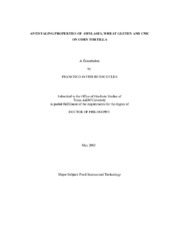| dc.contributor.advisor | Rooney, Lloyd W. | |
| dc.contributor.advisor | Waniska, Ralph D. | |
| dc.creator | Bueso Ucles, Francisco Javier | |
| dc.date.accessioned | 2004-09-30T01:40:19Z | |
| dc.date.available | 2004-09-30T01:40:19Z | |
| dc.date.created | 2003-05 | |
| dc.date.issued | 2004-09-30 | |
| dc.identifier.uri | https://hdl.handle.net/1969.1/19 | |
| dc.description.abstract | Antistaling properties of enzymes (xylanase, bacterial maltogenic and conventional a-amylases), CMC and vital wheat gluten on corn tortillas were evaluated during storage for up to 21 days. Effect of storage time (0-21 days) and temperature (-40, -20, 3, 10 and 21 oC) on tortilla staling was evaluated with or without additives.
Addition of 275-1650 AU of ICS maltogenic amylase effectively reduced amylopectin retrogradation without reducing tortilla yields, but did not improve tortilla flexibility.
The combination of 825 AU of ICS amylase (to interfere with intra-granular amylopectin re-crystallization) and 0.25% CMC (to create a more flexible inter-granular matrix than retrograded amylose) produced less stiff, equally flexible and less chewy tortillas than 0.5% CMC.
Corn tortilla staling followed the basic laws that control aging in starch-based semi-crystalline systems such as starch gels, bread and other baked products. Amylopectin re-crystallization was the driving force behind the staling of corn tortillas. Increasing levels of re-crystallized amylopectin measured by DSC correlated significantly with increased tortilla stiffness and reduction in tortilla rollability, pliability and rupture distance during storage.
Re-crystallization of amylopectin in fresh tortillas was not detected. It increased rapidly during the first 24 hr reaching a plateau after 7 days storage. The level of amylopectin re-crystallization on tortillas showed a bell-shaped trend along the evaluated storage temperature range with a maximum around 7 oC.
However, a negative linear relationship of peak pasting viscosity with storage temperature of tortilla extracts without additives after 21 days suggests other compounds besides amylopectin affect tortilla staling. Thus, interfering with amylopectin re-crystallization is not the only way to retard staling.
Further research is required to optimize the addition of maltogenic amylases in continuous processing lines that use fresh masa instead of nixtamalized corn flour, to determine how these amylases interfere with amylopectin re-crystallization and to elucidate if amylose retrogradation continues during storage and plays a role in tortilla staling. | en |
| dc.format.extent | 2684956 bytes | en |
| dc.format.extent | 195401 bytes | en |
| dc.format.medium | electronic | en |
| dc.format.mimetype | application/pdf | |
| dc.format.mimetype | text/plain | |
| dc.language.iso | en_US | |
| dc.publisher | Texas A&M University | |
| dc.subject | Tortilla staling | en |
| dc.subject | amylopectin recrystallization | en |
| dc.subject | maltogenic amylase | en |
| dc.subject | CMC | en |
| dc.title | Antistaling properties of amylases, wheat gluten and CMC on corn tortilla | en |
| dc.type | Book | en |
| dc.type | Thesis | en |
| thesis.degree.department | Soil and Crop Sciences | en |
| thesis.degree.discipline | Food Science and Technology | en |
| thesis.degree.grantor | Texas A&M University | en |
| thesis.degree.name | Doctor of Philosophy | en |
| thesis.degree.level | Doctoral | en |
| dc.contributor.committeeMember | Richter, Ronald L. | |
| dc.contributor.committeeMember | Moreira, Rosana | |
| dc.type.genre | Electronic Dissertation | en |
| dc.type.material | text | en |
| dc.format.digitalOrigin | born digital | en |


